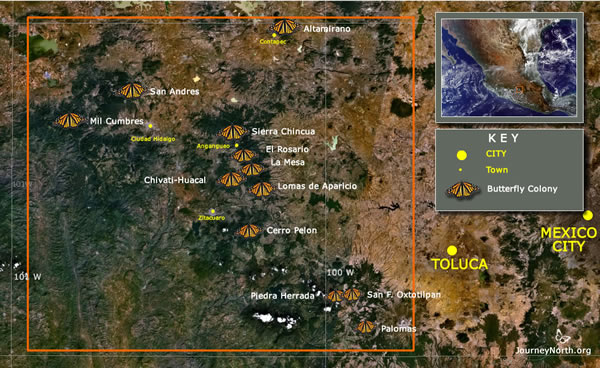
El Rosario Sanctuary welcomes visitors from around the world.
Dear Friends, Hello from the monarchs winter home in Michoacán, Mexico! Like everyone, we are waiting eagerly to know how many monarchs are here this winter. We hope the official count will show improvement over the recent record-low years. With this in mind, I went up to El Rosario Sanctuary and Sierra Chincua to ask the guides for their impressions. As usual, the number of monarchs in El Rosario Sanctuary is much larger than Sierra Chincua. There must be at least triple the number butterfly-filled trees at El Rosario. Here are some highlights of what I observed: El Rosario Sanctuary As I got nearer to the core of the colony, I just could not believe my eyes! It seemed as if I was looking to one of the best spectacles of the last years, in terms of population. Once in the core of the area, the trees were wonderful, filled with heavy and rather big clusters of monarchs: some a little more disperse, some long and wide in size, others so dark and heavy-dense loaded that it was just impressive to look at them. Tens and tens of trees were full with clusters – more than 50 trees covered-- on top, by one side, by the middle, with heavy clusters or lighter clusters hanging…It was a wonderful spectacle. On the other hand, the sound of their flying was as if we were inside a beehive! The number of monarchs flying around in response to the sun’s brightness was also high in number. On the walk to the colony, remains of last year’s storm in March can still be seen. There is an impressive root of an old fallen tree that calls the tourists’ attention. The canopy all around the way to the core of the colony seems very nice bright and alive and beautifully blossoming. Some traces of the damages of the wind storm in March, 2016 may be seen here or there with a tree-trunk still laying on the soil. There are also new signs showing the variety of fauna and flora inhabiting the forests. Sierra Chincua Sanctuary From what I observed, I'd guess think there’s normal density this year, about the same or slightly lower than as last year. About 12 to 15 trees comprise the population at the site up to now, but only 3-4 trees with the most density. The others have small, thin clusters, and rather very few butterflies. Clusters are normal small to medium and very few wanting to be rather thick and heavy. Two to three trees have got part of their trunk from the middle to short before the top, covered with live, very healthy monarchs. For 11 months, since last year’s wind, snow and ice storm, we have been worried. I was amazed to see so many butterflies at El Rosario. It is my impression — and many other people's — that the population this year may not as low as it was expected to be. It made me feel hopeful considering last March's devastating storm. But of course, we all should keep cautious, since scientists on the matter should have the last word on this season’s success in population for monarchs. Until next week, Estela Romero |
|
||||||||||||
|
|||||||||||||
Copyright Journey North (journeynorth.org). All Rights Reserved.











